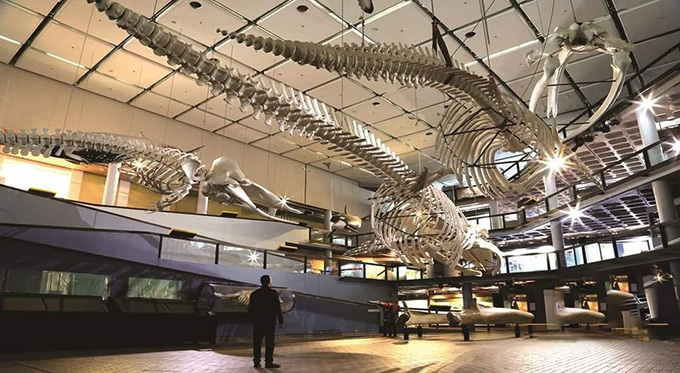
Picture your typical human evolution museum display. You walk into a dimly lit space with glass boxes on white plinths or roped off areas. There are lots and lots of bones. Maybe a bit of history on how those bones were collected, and pictures of the famous people – usually men – who collected them. Often there are reconstructions of what these human ancestors might have looked like: dark-skinned and hairless ape-people, walking, mostly naked, holding stone tools, or even being hunted.
But where are you? How does such an exhibit show you who you are and how you came to be? We don’t think it does. So, in 2018 we were among a group of human evolution researchers who decided it was time to do things differently. The result is Humanity, a new human evolution exhibit that opened in September 2023 at Iziko South African Museum in Cape Town.
The exhibit offers a close look at the problematic history of palaeoanthropology; it also attempts to decolonise the story of human origins. To do so, it looks at how human evolution has been portrayed in the past, in ways that reinforce western biases and alienate and dehumanise living Africans. Then it works to remove those biases and make our understanding of human evolution scientifically accurate, broadly relevant and inclusive.
This is part of a broader reckoning happening in museum practice globally. Many institutions are reconsidering their collections and their roles as participants in colonial practice, including theft of artefacts and bodies. It is essential to consider how museums continue to alienate precisely the people who are owed reparations.
We learned an enormous amount while developing this exhibit, which is now a permanent fixture at the museum. Our hope is that these four central lessons could help other institutions locally and internationally to reconsider how they portray human evolution – and to understand why it matters.
A learning process
1. Make the co-creation process as inclusive as possible:
The Humanity exhibit was created through a collaborative process involving curators, researchers, collections managers, designers, conservators, educators, artists, heritage practitioners, community members, public participants, procurement specialists, service providers and administrators.
In this process, our plans changed often, when a diversity of lenses showed us where content and design missed the mark. The product is radically different from what we thought we would create. It is richer for that.
2. Lose the “great white explorer” narrative:
The history of human evolution is traditionally told as a story of white male exploration and discovery. South Africans learn in school and through the media about Raymond Dart, Robert Broom, Phillip Tobias, Lee Berger and other mostly foreign, English-speaking white men who are associated with important fossil discoveries in the country.
In contrast, we centred the exhibit’s story on the diversity of people in South Africa and how that diversity came to be.
This was done through portraiture, genetic testing and interviews about cultural identity to explore, through individuals, what makes them “them”. Interviewees spoke in the South African languages of their choice. This exploration of our collective humanity was used as an inroad for understanding how evolution has worked to shape us into what we are today.
3. Own the problematic past:
Early South African palaeoanthropologists didn’t only find fossils: they also often engaged in colonial, racist science, studying and measuring living people as models for our “primitive” ancestors.
Even the iconography of human evolution has racist, colonial overtones. A Google Image search for “human evolution” will turn up a trove of images depicting evolution as a line of hominins transitioning from more ape-like to more human-like. Often the earlier ones are more hunched, hairier, and darker, suggesting a link between black bodies and primitiveness, while the end product is a striding white man.
We put in place a number of interventions to deal with this legacy. The exhibit openly discusses race and racism, as well as the history of palaeoanthropology and institutions like Iziko Museum in propping up racist science. This is crucial because, although racial categories are meaningless biologically, they have had adverse social effects.
The theme of human connection is threaded through the whole exhibit. This shows how human evolution is not linear, but rather a braided stream – a view consistent with cutting-edge science. It also shows how the origin of our species is pan-African, and includes contributions from beyond Africa, and how this has made humanity more variable and more resilient.
4. Break the glass boxes:
Probably the biggest surprise as we developed this exhibit, at least for those of us raised going to museums, was how alienating museums actually are to most people.
Museums are a western notion. Putting heritage objects behind glass and on pedestals in sterile spaces is not only alienating, it can be downright offensive. The Humanity exhibit does not fit traditional museum aesthetics.
Instead, visitors are drawn into a welcoming space enveloped in a reed structure that resembles a giant basket, or a hut, staring up at the African sky. A wall of 100 handaxes is there to be touched, as are some important fossil casts. Gone are the scientific illustrations and realistically painted past landscapes. Instead, stories are communicated using art that is familiar to everyone – photographs, videos, animations, comic strips and graffiti.
Everyone’s story
The story of humanity is everyone’s story. A story of migration and mixing, and adapting to new contexts. It is a story of the connection of people along the long braided stream of our shared origins. It is important that we tell it that way.
Author Bios: Rebecca Ackermann is a Professor, Department of Archaeology and Human Evolution Research Institute at the University of Cape Town and Wendy Black is Chief Curator of Art & Social History at Iziko Museums of South Africa
